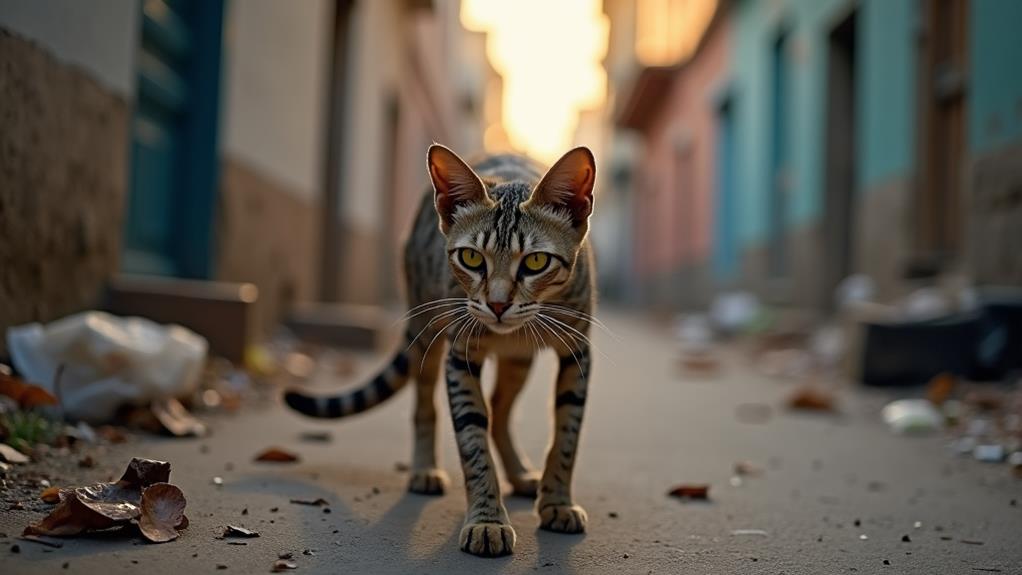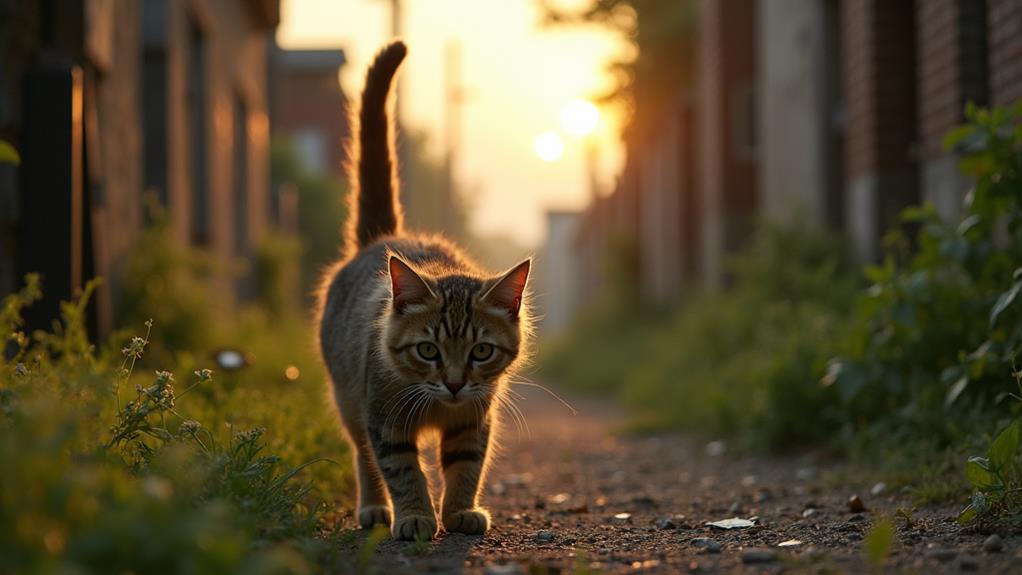How to Tell if a Feral Cat Is Pregnant: Signs and Symptoms
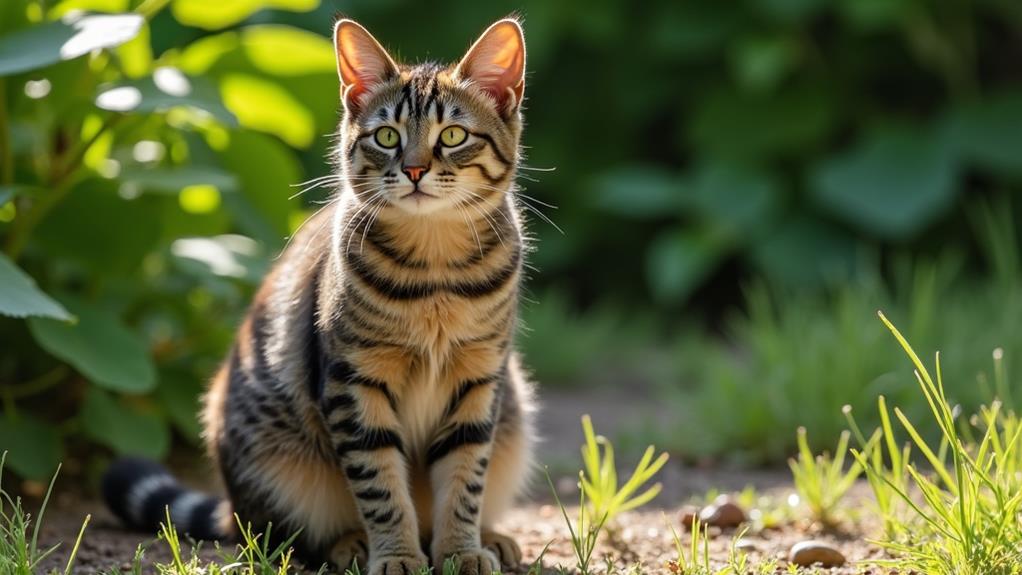
To tell if a feral cat is pregnant, look for noticeable weight gain and "pinking up" of her nipples around day 15. Her abdomen will swell midway through the roughly 64-67 day gestation. Increased appetite and nesting behavior indicate she's preparing for kittens. You might see her seeking solitary, quiet spots and becoming more affectionate or vocal. Her fur could shine more due to hormonal shifts. Watch for kitten movements in later stages. If she's eating more yet seems sick, consider other health issues. With these clues, you'll better understand the signs and be prepared for what's next.
Physical Changes in Cats
During pregnancy, a cat undergoes several distinct physical changes that can help you determine if she's expecting. Pregnant cats, or queens, typically show noticeable weight gain. As the pregnancy progresses, this can exceed 50% of their baseline body weight. This weight gain is one of the initial signs and symptoms you might observe. Around day 15 of the gestation period, you'll notice her nipples starting to "pink up." This means they become enlarged and more prominent—a clear indicator of pregnancy.
Another physical change to watch for is the swelling of your feline friend's abdomen. By the halfway point of the gestation period, which lasts about 64-67 days, her belly will begin to swell and appear rounded. This change is usually quite noticeable and is a reliable sign of pregnancy. Moreover, the fur condition of pregnant cats often improves, becoming shinier and healthier due to hormonal changes.
As the pregnancy advances, you might even feel or see movement in her belly. This occurs as the kittens grow and become more active, particularly in the later stages. These physical changes are key indicators that your feline friend is expecting.
Behavioral Signs of Pregnancy
A pregnant feral queen might surprise you with her sudden change in behavior. One of the primary signs that a stray cat is pregnant is her nesting behaviors. She'll seek out a safe, quiet place to prepare for birthing, often spending more time in these chosen spots. You might notice this female cat showing increased vocalization, especially as her pregnancy progresses. These behavioral changes can be a clear indicator that she's expecting.
Interestingly, a pregnant feral cat might become more affectionate towards humans, which is a stark contrast to her usual standoffish nature. She may seek comfort and closeness, showing a side of her personality that's unexpected. Keep an eye on her activity levels too. As she nears the end of her gestation period, you'll observe reduced activity levels. She'll prefer resting and conserving energy over her usual roaming.
Additionally, some feral queens prefer solitude during pregnancy, retreating to secluded areas away from other animals and disturbances. These behavioral shifts can help you identify when a stray cat is pregnant, allowing you to provide the necessary support and care during this vital time.
Appetite and Eating Patterns
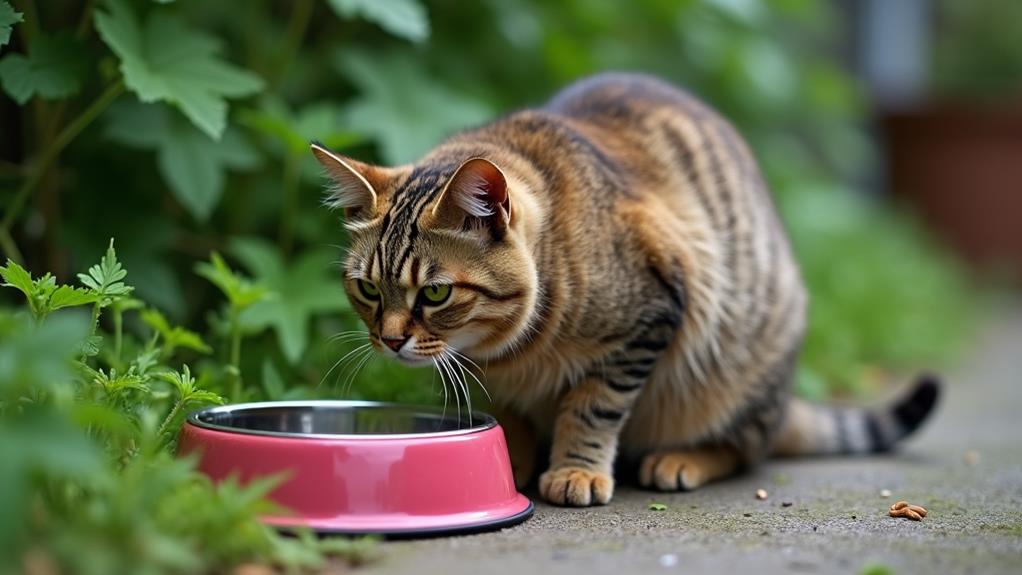
When observing a feral cat's appetite and eating patterns, you might notice some significant changes that could indicate pregnancy. A pregnant stray often shows an increased appetite, requiring around 25% more food than she normally would. This increase in food intake supports the growth of her kittens as the pregnancy progresses. Notably, early in pregnancy, some feral queens might experience a temporary loss of appetite or even specific food cravings, resembling morning sickness in humans.
As the pregnancy advances, the cat's feeding frequency noticeably increases. This is a clear sign of her heightened nutritional needs, vital for the healthy development of her kittens. By closely monitoring these feeding patterns, you can gain valuable insights into her health status. While an increased appetite often points to pregnancy, it's significant to keep in mind that any notable changes in eating habits might also indicate other health issues.
Regularly observing the eating patterns of feral cats is key, as they're usually less visible than domesticated ones. This vigilance helps you identify potential pregnancies early on, ensuring that any necessary support is provided to meet their nutritional needs during this pivotal time.
Health and Medical Indicators
In conjunction with changes in appetite, paying close attention to health and medical indicators can help you determine if a feral cat is pregnant. One early sign of pregnancy is morning sickness, which may manifest as occasional vomiting. This typically occurs in the early stages and can be a useful clue. Another indicator is the cat's nipples becoming enlarged and reddened, a change known as "pinking up," which usually appears around day 15 of pregnancy. This is a clear sign that the cat's body is preparing for nursing.
You might also notice a discharge from the vulva. While this can indicate pregnancy, it's vital to watch for any changes or abnormalities in the discharge that could suggest health issues. Furthermore, observe the cat's weight during pregnancy. A significant weight increase, sometimes over 50% of the cat's baseline weight, can be a sign of pregnancy, though it might also be mistaken for obesity.
For definitive confirmation, seek veterinary confirmation. Blood tests for relaxin hormone or an ultrasound can accurately determine pregnancy status in feral cats. These methods provide reliable signs of pregnancy, helping you differentiate cat pregnancies from other health conditions.
Understanding the Pregnancy Timeline

To understand a feral cat's pregnancy timeline, start by noting that the average gestation period is about 64-67 days. During this time, you'll observe different signs of pregnancy that can help confirm if a cat is expecting. Early in the gestation period, pregnant cats may not show obvious changes, but within the initial few weeks, you might notice subtle signs.
As the pregnancy progresses, keep an eye out for the following:
- Physical changes: Around 4-5 weeks, the cat's nipples enlarge and her abdomen swells.
- Nesting behavior: As she nears giving birth, often in the final week, she'll start preparing a safe, quiet place.
- Kittens moving: By the end of the gestation period, you might feel the kittens moving inside her abdomen.
- Regular veterinary check-ups: These are crucial for monitoring the cat's health and confirming pregnancy status.
Importance of Spaying and Neutering
Spotting signs of pregnancy in a feral cat can be a rewarding challenge, but it's just as fundamental to contemplate the broader implications of feline reproduction. One of the most effective ways to address these implications is through spaying and neutering. By spaying female cats, you considerably reduce the risk of unwanted litters, which is imperative for controlling the feral cat population. Female cats can become pregnant as early as four months old, so early spaying is vital to prevent unwanted pregnancies and help curb overpopulation in your community.
Spaying isn't just about preventing more stray cats; it also reduces the likelihood of health problems such as uterine infections and certain cancers in female cats. Neutering male cats is similarly important. It reduces aggressive behaviors like fighting and territorial marking, contributing to a more stable and peaceful environment.
With approximately 3.4 million cats entering shelters annually in the U.S., spaying and neutering play a key role in animal welfare. They prevent the cycle of homelessness and ease the burden on animal rescue organizations. By taking these steps, you're actively contributing to a healthier, more balanced ecosystem.
Preparing for Kitten Arrival
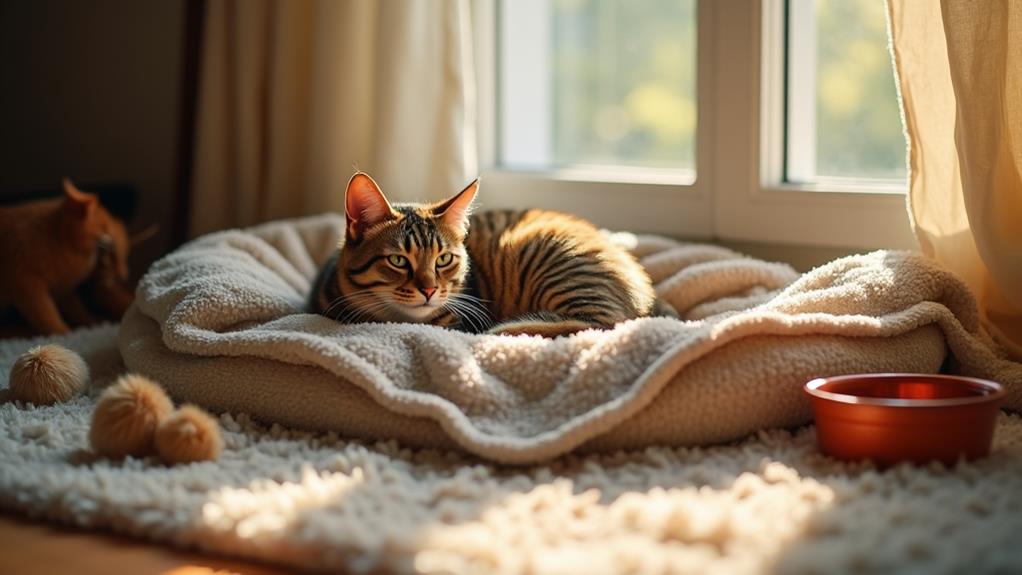
As you prepare for the arrival of kittens, creating a cozy nesting area is vital for the comfort and safety of a pregnant feral cat. Choose a quiet, secure location and set up soft bedding to guarantee the mother cat feels at ease. This nesting area should provide a calm environment, reducing stress and disturbances during labor and delivery.
To meet the increased nutritional needs of the mother cat, make certain the nesting area is always stocked with fresh water and high-quality food. This will support her health and the development of her kittens. Keep the environment stable and quiet, which helps the mother cat feel secure as she approaches labor.
Regularly monitor the mother cat's health and behavior. Be aware of signs of labor, such as increased restlessness or nesting behavior, often visible about a week before delivery. Preparing for potential complications is fundamental, so have contact information for a veterinarian ready in case emergency assistance is needed.
- Set up a cozy nesting area with soft bedding
- Guarantee access to fresh water and high-quality food
- Maintain a calm environment to reduce stress
- Monitor health and note signs of labor


